Children’s Literature of the Harlem Renaissance by African American Women
African American Authors
African American Female Authors
Most of these books are poetry, which was one of the popular forms of literature during the Harlem Renaissance. A couple of books in the illustrator group fit in this category. However, the goal there was to highlight artwork, regardless of who the author is.
All these women made great strides in African American literature. Some are famous poets, some wrote stories with different genres, some had famous spouses or were generally famous themselves.
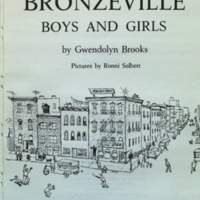
Gwendolyn Brooks, Author (African American, 1917-2000)
Bronzeville boys and girls
Harper and Row
1956
Ink on paper
PZ8.3.B788 Br
For those who have spent time in a big city, the experiences of these children might be relatable. They party with friends and spend time alone. They experience ever-changing weather. However, not all experiences are positive. There is little sugar coating for the hard times that fall upon certain families. Children experience frustration, fear, and loneliness. Brooks validates children’s emotions. It is okay to cry and be angry, to laugh and be silly.
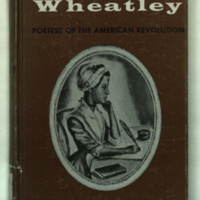
Shirley Graham Du Bois, Author (African American, 1896-1977)
The Story of Phillis Wheatley
1949
Julian Messner
PZ7.D8523 ST
Who is Phillis Wheatley? Slightly dramatized, Wheatley’s life is detailed from younger years to her untimely death. In her short life, Wheatley gained notoriety when she published her work. Although enslaved, she was exceptionally educated. Even with her education and popularity as a writer, she became poverty stricken and never recovered. Although multiple factors pushed her into obscurity, her work is appreciated to this day.
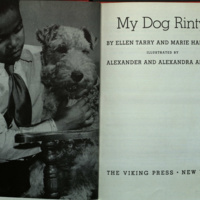
Ellen Tarry, Author (African American, 1906-2008) and Marie Hall Ets
My Dog Rinty
The Viking Press
1946
Black and white photographs
PZ10.3.T1386 My
A child and their pet; stories with this premise existed for decades. David struggles to keep Rinty, a lovable yet troublemaking mutt, from upsetting the townspeople. During their misadventures, they explore several locations in Harlem. Those who are annoyed by the pair eventually change their minds when Rinty’s true potential is shown. Everyone learns not to take someone’s worth at face value.
African American male authors
Many men and women were active or started their literary careers during the Harlem Renaissance. The books in this group are created by famous men, along with lesser known men.
Prolific poets Bontemps and Hughes were friends; they collaborated on projects geared towards young adults and children. Despite his declining marriage and health, Dunbar also had a successful career. Not only were Jackson’s novels a reflection of his life, they reflected the lives of others who faced adversity. Today, the works of these writers are read, referenced, and renowned.
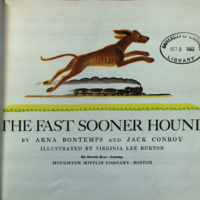
Arna Bontemps, Author (African American, 1902-1973)
The fast Sooner hound
1942
Houghton Mifflin Company
PZ8.1.B63 Fas
This book is a collaboration between non-Black and Black authors and illustrators. Burton collaborated with other authors, including Bontemps. These connections helped Harlem Renaissance creators produce their books for a wider market. The book, with its vivid imagery and plot as fast paced as the Sooner, might offer social commentary. The Boomer represents the poor; the Engineer and Roadmaster represent the rich.
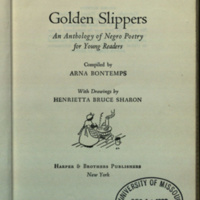
Arna Bontemps, Author (African American, 1902-1973)
Golden slippers: an anthology of Negro poetry for young readers
1941
Harper and Brothers
PS591.N4 B6
Traditional poetry juxtaposes with works of poets. Many of the writers were active during the Harlem Renaissance. A couple of them are solely children’s book authors. Many participate in community organizations, playwrighting, and poetry. Regarding each piece, jargon varies between each author. The slippers have their own poem, rich with dialect. That poem balances deep messages; reflecting on one’s past and hoping for the future.
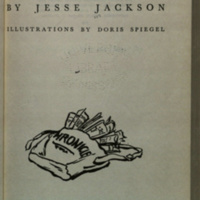
Jesse Jackson, Author (African American, 1908-1983)
Call me Charley
1945
Harper and Row
PZ7.J13624 Cal
Charley’s story portrays the unfortunate reality that African American children faced at the time. The only African American student in his new school, he is subjected to racism. Although the story has little to do with the book, the impact of negative stereotypes in children’s literature is explored in detail.
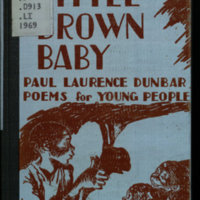
Paul Laurence Dunbar, Author (African American, 1872-1906)
Little brown baby: poems for young people
1969
Dodd, Mead and Company
PZ8.3.D913.LI 1969
Dunbar reflects on his childhood in this anthology, which is written in traditional Black dialect. Not only are the stories interesting, they examine life lessons and morals. They also empower African American children; the poem Little Brown Baby is a prime example of this. To instill hope and pride in children, especially when they have been ostracized for a long time, is vital.